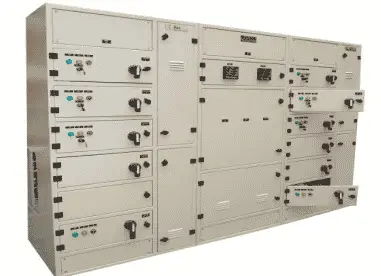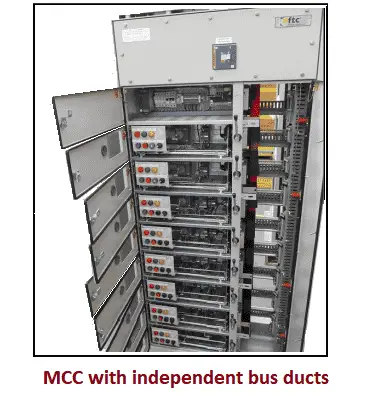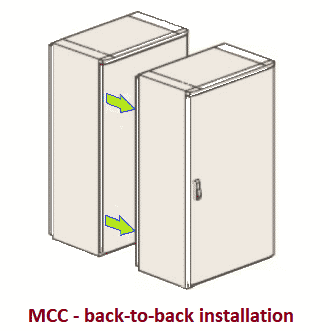A Motor Control Center (MCC) has a metal enclosure in which switchgear is installed. Its abbreviated form is MCC. The MCC Panels feed power to motors and other electrical equipment. It also controls and protects circuits.
The MCC mainly feeds and controls the power of motors. The MCC has mainly contactors or starters as the main control components.
Before discussing motor control centers, let us go through the difference before starting using and after using them.
In the past:
In a production plant, there were quite a few motors of different capabilities distributed throughout the facility. It was necessary to govern and to take care and each one had to be attended to on its board for corrective maintenance or preventive maintenance in a decentralized way. This results in a significant waste of time in the productive process.
Over time, electronic systems have been added. As a result of the implementation of the electronic relays, mechanical or electromechanical relays were replaced. With this change, electrical and mechanical variables were supervised using remote controls.
At present:
The MCCs have evolved to the point of controlling, supervising, and communicating the parameters established in their logic. In addition to having different constructive forms of MCC, depending on the desired application. These MCCs are intelligent MCC that has communication with PLC and SCADA.
Purpose of Motor Control Centers

A Motor Control Center has a metal enclosure having the function of feeding, controlling, and protecting circuits whose primary load consists of motors. Hence, motors that use a starter (contactors and relays) as the main components of control.
Each industry, however, has its own motor control requirements that must be considered before the installation.
Characteristics of the motor control center
- It has combined units for motor control, which is what differentiates it from other device control centers.
- They can work manually or automatically.
- They offer overload protection.
- The MCC together with a programmable logic controller (PLC) allows minimizing the set of devices preventing the maneuver based on relays and timers.
- One of its main properties is the ability to provide security.

Implementation of the motor control center in the industry
The utility of motor control centers is appropriate for all those industries and plants that work with electric motors, being its most common use in industries for the processing of food products, chemicals, pharmaceuticals petroleum products, power plants, factories, or household appliances and electronics

Motor control centers are classified in various ways. Let us discuss wiring classes, types of wiring, and types of construction in this article.
Classification of Motor Control Center according to Wiring Class :
Class I
Every built-in compartment or tray must have its own wiring and it cannot connect to any other part of the motor control center of the motors. No interlocking operation is between other motors, and only a limited number of motors are arranged.
Class II
This kind of wiring must be exclusive for each integrated compartment or tray and it is own of it to have interconnection with other internal or external parts of the control center of the motors. Such as mechanical interlocks and external control systems.
Classification of Motor Control Center according to Types of Wiring
1. Type A Wiring
It is wiring that does not have terminal block terminals for the power and control circuits in a motor control center(MCC).
2. Type B Wiring
Wiring with terminal blocks located next to or between each integrated drawer and tray in the motor control center (MCC).
3. Type C Wiring
In the arrangement of individual terminal blocks for control and power, for each of the integrated compartments or trays that comprise the motor control center.
Classification of Motor Control Center according to Types of Construction
The IEC 61439-2 standard, specifies the construction characteristics and deals with the forms of disintegration internal to the assemblies employing barriers or partitions.
Find below the list of different typical forms:
Form 1: Without any kind of segregation between components.
Form 2a: The terminals for external conductors do not need to be separated from bus bars.
Form 2b: The terminals for external conductors are separated from the bus bars.
Form 3a: The connection terminals must be separated from the bus bars.
Form 3b: Connection terminals must be separated from the bus bars.
Form 4a: The connection terminals are in the same compartment that the functional unit associated.
Form 4b: The connection terminals are not they are in the same compartment that the associated functional unit. Must go in a compartment single and separate without any kind of segregation between components.
Advantages of motor control centers
Some of the main advantages of the electrical control panel for motors are:
They group together within the same board the motor starter systems of different areas of a plant, as well as the distribution system.
- Supervision can be carried out effectively with these systems.
- They allow the starters to be centralized.
- MCC reduces costs since all feeder lines reach one location.
- Allows organization and order to be maintained between the staring systems and the motors.
- Ensures greater security for the users.
- MCC can protect against possible electrical failures.
- They are of great help to modify the functions of the motor, without any problem.